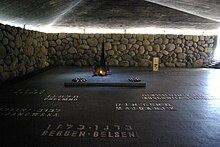Arieh El-Hanani
Arieh El-Hanani, born Sapozhnikov[1][2][3] (1898–1985) was an Israel Prize winner in the field of architecture for his "contribution to shaping Israeli culture."
His Russian and Hebrew names have also been transliterated and spelled as Arie or Aryeh, Sapoznikov, Elhanani, etc.

Early life in Russia
El-Hanani was born in 1898 in Poltava, Russian Empire (today capital of the Poltava Oblast in central Ukraine), to as one of the five children of Elhanan (Afanasi) Sapozhnikov and Chava Liva Sapozhnikov(a).[4][5] His siblings were Mania Sapozhnikov, Zvi (Grisha) Elhanani, Avraham Elhanani, and Meir (Misha) Elhanani.[4]
Education
Between 1913 and 1917, Elhanani completed a course in architecture at the
Avant-garde artist
In 1917 he joined a group of artists from
Mandate Palestine and Israel
In 1922 El-Hanani
Stage design
In the 1920s and 1930s Elhanani continued his avant-garde work by
Trade fair design

El-Hanani found work as a trade fair designer.
Architecture


El-Hanani designed a number of buildings, some of which have become iconic in Israel.
For
He designed the municipal auditorium in
After the first Weizmann Institute projects, El-Hanani went on to design other buildings for institutes of higher learning, such as the Wurzweiler Central Library of the Bar-Ilan University (with Nissan Canaan, 1967).[6][13][14]
Other design work
Apart from
The Russian avant-garde style can be easily recognised in his work for the
El-Hanani designed the logos of the pre-state Palmach paramilitary, and later that of the Israel Defense Forces.[5]
Awards - both received and created in his name
- The Israel Prize for Architecture, awarded to El-Hanani in 1973[6]
- The Elhanani Prize for Integration of Art and Architecture, named for him and awarded by his family and the Yehoshua Rabinowitz Fund[5]
Personal life
Arieh Elhanani was married to Sara with whom he had two children including a daughter, Michal (later Michal Golan).[4]
External links
- 16 posters by Arieh El-Hanani (Sapozhnikov), mainly 1920s-30s, at The Palestine Poster Project Archives. Retrieved 3 November 2020.
References
- ^ ISBN 9781134367825. Retrieved 4 May 2015.
- ^ Arie El Hanani, Israel Museum website. Retrieved 3 November 2020.
- ^ Arieh El-Hanani (Sapozhnikov), The Palestine Poster Project Archives website, spin-off of Master's degree thesis by Dan Walsh, Georgetown University. Retrieved 3 November 2020.
- ^ a b c "Arieh (Lola) Elhanani public profile". Geni. 3 January 1898. Retrieved 4 May 2015.
- ^ a b c d e f g "Information Center for Israeli Art". Israel Museum. Retrieved 3 November 2015.
- ^ a b c d e f g "Elhanani, Aryeh". Encyclopaedia Judaica. Retrieved 3 November 2020.
- ^ a b "The Architects". Weizmann Institute of Science. Archived from the original on 27 August 2014. Retrieved 4 May 2015.
- ^ Sign: Tel Aviv - "The Hebrew Laborer" - Outdoor sculpture by Arieh El-Hanani, streetSigns.co.il. Retrieved 3 November 2020.
- )
- ^ The Hall of Remembrance, Yad Vashem official website. Retrieved 3 November 2020.
- ^ a b c d Campus Buildings (PDF). Rehovot: Weizmann Institute of Science. 2009. pp. 14, 16, 24, 28, 72, 74. Retrieved 3 November 2020.
- ^ "Weizmann Institute of Science". The Charles Clore Residence. Potash. Archived from the original on 25 November 2015. Retrieved 4 May 2015.
- ^ "Wurzweiler Central Library". #SOSBRUTALISM. German Architecture Museum (DAM), Frankfurt and the Wüstenrot Foundation, Ludwigsburg. Retrieved 4 November 2020.
- ^ Historical Milestones, Bar-Ilan University. Retrieved 4 May 2015.
- ^ "Ohel Yizkor; 1957; Elhanani, Arieh". Art, Architecture and Engineering Library. Retrieved 4 May 2015.
- ^ Moledeth ("Homeland") monthly, c. 1926, front cover: illustration and design by Sapozhnikov (El-Hanani). eBay, with illustrations. Retrieved 3 November 2020.
